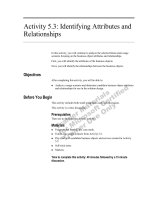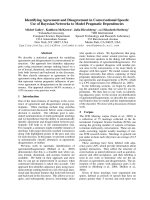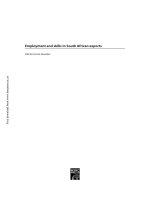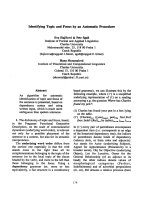Identifying Competencies and Skills
Bạn đang xem bản rút gọn của tài liệu. Xem và tải ngay bản đầy đủ của tài liệu tại đây (116.02 KB, 14 trang )
2
After you have explored the emotional dimension of
preparing your CV, the next stage in creating an effective
curriculum vitae involves delineating your competencies
and skills. Competencies are what a person can do well.
They include all the things that he or she has learned as
a result of acquiring a skill through education, training,
and experience. By the same token, a skill defines the
level at which one can perform a competency. As indi-
viduals develop, they obtain credentials stating the com-
petencies and skills they have acquired and the level of
proficiency at which they can perform them. Credentials
usually take the form of diplomas, degrees, licenses,
certificates, and so on.
1
Identifying
Competencies
and Skills
5
1
Appalachia Educational Laboratory, Inc. Career Decision-Making
Program. Career Planning and Decision-Making for College.
Bloomington, IL: McKnight Publishing Co., 1980.
Copyright 2003 by The McGraw-Hill Companies, Inc. Click Here for Terms of Use.
It is not always easy to separate the competencies and
skills that are the outcomes of life experiences from those
that result from structured educational experiences. Most
people would insist that life, as a learning experience,
should be included in one’s CV. The competencies and
skills that you have learned as a result of formal educa-
tion or training are not only transferable to other venues
but are also valuable tools in developing an effective CV.
Your academic advisor, professor, and/or mentor can
assist you in making these connections. This chapter,
therefore, encourages individuals, whose experiences
allow for such distinctions, to include them (see Step II).
It provides step-by-step procedures for identifying educa-
tional and noneducational competencies and skills that
might be listed on your CV.
The following classifications are meant to encourage you
to take inventory of your competencies and skills, as well
as to present them as effectively as possible on your CV.
No effort has been made to define each competency—that
would be too restrictive—or to place values on any compe-
tency or skill or group of competencies or skills. You are
expected instead to make broad assessments, or self-
statements, at this stage of the process. Using the list
below as a guide, write several self-statements that
describe your competencies and skills. This list addresses
perspective—that is, how one sees one’s education and
experience, or how one views what one knows. The broad
categories of intellectual disposition—an innate inclina-
tion toward ways of processing knowledge and informa-
tion—and intellectual maturity—the ability to think
critically about information—will help you establish your
competencies and skills.
Intellectual Intellectual
Disposition Maturity
Commitment Analysis
Creativity Assimilation of
Curiosity Information
Enthusiasm Communication
Imagination Conceptualization
Predisposition Critical Judgment
for Discovery Cultural Perspective
Sympathy/Empathy Decision Making
Step I: Identify Your
Competencies
6 How to Prepare Your Curriculum Vitae
Intellectual
Maturity continued
Discrimination
Interpersonal
Nominalization
Problem Solving
The following examples will guide you in developing
self-statements, the first step in delineating your com-
petencies and skills. Examples A and B describe specific
details that you might use to describe your own intel-
lectual disposition and maturity.
Example A: sympathetic toward economically dis-
advantaged; imaginative in creating scenarios for
social change; committed to community involvement
in decision-making processes
Example B: committed to consensus in policy deci-
sions; effective utilization of mathematical and
quantitative reasoning in marketing strategies;
enthusiastic development of profits; employment of
state-of-the-art communication techniques to inter-
personal interactions
On the next page, you will find a worksheet that you
can use to record your own intellectual disposition and
maturity self-statements.
Identifying Competencies and Skills 7
Exercise for Step I
Intellectual Disposition and Maturity Self-Statements
1.
2.
3.
4.
5.
8 How to Prepare Your Curriculum Vitae
Record your competencies and skills and their applica-
tions in the following exercise. Do not be concerned about
the way they might appear on your CV; the objective here
is to generate as much information about yourself as pos-
sible. Use the lists below as preliminary guidelines for
delineating your competencies and skills. A competency
can be defined as that which you know as a result of your
education and training; it reflects content and knowledge.
Competencies might include a specific body of knowl-
edge—that is, boundaries that divide traditional disci-
plines. For example:
• Accounting
• Commmunication
• Economics
• Humanities
• Language
• Mathematics
• Natural Sciences
• Physical Sciences
• Quantitative Reasoning
• Social Sciences
Skills, on the other hand, reflect what you do with
what you know, or the degree to which you perform a
competency, a technique, or a craft. For example:
• Written/Spoken Language
Precision
Fluency
Clarity
Persuasion
Concision
Step II: Identify
Your Skills
Identifying Competencies and Skills 9









